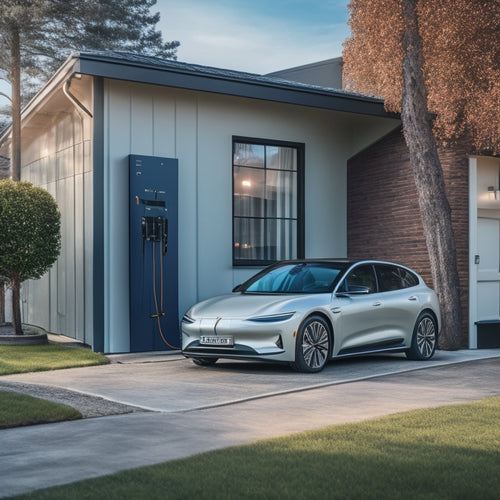
7 Essential Tips for Efficient Panel Performance
Share
You can boost your solar panel system's energy output and lifespan by implementing a combination of key strategies. Start by monitoring energy production closely to identify trends and anomalies. Optimize your panel's angle and tilt to guarantee maximum energy harvesting. Regular cleaning and addressing shading issues can also greatly improve performance. Proper inverter sizing, regular system checks, and analyzing energy usage patterns are also vital. By following these essential tips, you'll be well on your way to maximizing your system's potential. To discover even more ways to optimize your solar panel performance, keep exploring.
Key Takeaways
• Regularly track energy production data to identify trends, anomalies, and areas for improvement in panel performance.
• Optimize panel angle and tilt to maximize energy harvesting, considering latitude, time of year, and panel orientation.
• Clean panels regularly to prevent energy loss due to dust and debris accumulation, and inspect for buildup.
• Ensure proper inverter sizing by conducting load calculations and analyzing system design and energy conversion needs.
• Conduct regular system checks to verify configuration, inspect for wear and tear, and perform battery maintenance to maintain peak performance.
Monitor Energy Production Closely
To optimize panel performance, you should track your energy production data regularly, as it allows you to identify trends, detect anomalies, and make informed decisions to maximize your energy yield.
Energy tracking is essential for understanding your system's performance and identifying areas for improvement. By monitoring your energy production closely, you can pinpoint periods of underperformance and take corrective action to get your system back on track.
Regular energy tracking also enables you to set realistic performance metrics, allowing you to evaluate your system's efficiency and make data-driven decisions. You'll be able to identify opportunities to optimize your energy production, such as adjusting your panel's angle or cleaning debris from the surface.
Optimize Panel Angle and Tilt
When optimizing your panel's angle and tilt, you'll want to calculate the ideal angle to maximize energy harvesting. This calculation takes into account your location's latitude, the time of year, and the panel's orientation.
Ideal Angle Calculation
You can maximize your solar panel's energy output by calculating the ideal angle, which depends on your location's latitude, the time of year, and the panel's orientation. To get it just right, you'll need to take into account the sun's path across the sky, considering the changing seasons.
A general rule of thumb is to set the angle equal to your latitude, but this can vary depending on your specific location. For instance, if you're near the equator, a more horizontal angle is suitable, while at higher latitudes, a steeper angle is required.
When calculating the ideal angle, you'll need to make sure your panel's structural integrity isn't compromised. This means taking into account factors like wind resistance and snow loads, which can affect the panel's angular momentum.
By optimizing the angle, you'll not only boost energy output but also guarantee a longer lifespan for your panels. Remember, a well-calculated angle is important for maximizing energy production and reducing maintenance costs.
Maximizing Energy Harvesting
By skillfully adjusting the panel's angle and tilt, you can tap into the full energy-harvesting potential of your solar panel system, greatly impacting its overall performance and efficiency. This critical step guarantees you're maximizing the energy your system produces, which is especially important when considering energy storage for later use.
To get the most out of your solar panel system:
-
Optimize for seasonal changes: Adjust the tilt and angle to accommodate seasonal changes in the sun's position, ensuring maximum energy harvesting throughout the year.
-
Consider local environmental factors: Take into account local shading, wind, and snow loads to ensure your system can withstand environmental stresses.
-
Monitor and adjust: Regularly monitor your system's performance and adjust the angle and tilt as needed to guarantee efficient energy harvesting.
Clean Panels Regularly for Efficiency
As you work to maximize your panel's energy output, it's important to prioritize regular cleaning to prevent energy loss.
Dust and debris accumulation can greatly reduce your panel's efficiency, so it's vital to remove them regularly.
Dust and Debris Removal
Regular cleaning of solar panels is essential, as even a thin layer of dust and debris can greatly diminish their energy output, reducing overall system efficiency by up to 25%. When you neglect to clean your panels, you're allowing dust accumulation to hinder your system's performance.
Debris impact can also lead to a significant decrease in energy production. To keep your panels running at their best, make it a habit to:
- Inspect your panels regularly for signs of dust and debris buildup
- Clean your panels using a soft-bristled brush or a cleaning solution specifically designed for solar panels
- Schedule regular cleaning sessions, ideally during the cooler parts of the day to minimize energy loss
Preventing Energy Loss
To maximize your solar panel system's energy output, you must prioritize regular cleaning to prevent energy loss, as even a small amount of dust and debris can considerably reduce panel efficiency. A clean panel ensures peak energy production, and maintaining your system regularly is vital.
| Dust and Debris | Energy Loss | Efficiency Reduction |
|---|---|---|
| Light dusting | 1-2% | 0.5-1% |
| Moderate dirt buildup | 5-10% | 2-5% |
| Heavy soiling | 20-30% | 10-15% |
Regular cleaning also helps prevent thermal bridging, which occurs when heat is transferred through gaps in the insulation, reducing the system's overall efficiency. Insulation gaps can lead to significant energy losses, making consistent maintenance important. By keeping your panels clean and well-maintained, you can ensure top energy production, reduce energy losses, and maximize your return on investment.
Identify and Fix Shading Issues
During the installation process, inspect the panel's surroundings to confirm that no objects, including trees, buildings, or other obstructions, cast shadows on the panel, which can greatly diminish its performance. Shading issues can greatly reduce the energy output of your solar panel system, making it essential to identify and address them promptly.
To guarantee peak performance, take the following steps:
-
Trim trees and bushes: Regular tree pruning can help minimize shading issues. Remove any branches or leaves that may be obstructing sunlight from reaching your solar panels.
-
Clear roof obstructions: Ensure that your roof is clear of debris, vents, and other obstructions that may cast shadows on your solar panels.
-
Monitor panel performance: Regularly monitor your solar panel's performance to detect any potential shading issues. This will help you identify and address problems promptly, ensuring maximum energy output.
Ensure Proper Inverter Sizing
Sizing your inverter correctly is crucial, as an undersized inverter can lead to energy losses, while an oversized one can increase your upfront costs. To guarantee proper inverter sizing, you need to conduct a thorough load calculation, taking into account the total power requirement of your system.
This involves analyzing your system design and energy conversion needs to determine the best-suited inverter size.
During the inverter selection process, consider factors like power optimization, system integration, and energy conversion efficiency. By choosing the right inverter, you can maximize your system's performance and reduce energy losses.
A well-sized inverter will also help you achieve peak power optimization, ensuring that your system operates at its finest.
Perform Regular System Checks
Regular system checks are essential to identify and address potential issues before they escalate into major problems, allowing you to maintain peak system performance and prevent energy losses. By performing regular system checks, you can identify areas that require attention, making sure that your system operates at its best.
Here are some key aspects to focus on during your system checks:
-
Verify system configuration: Confirm that your system is configured correctly, and that all components are functioning as intended.
-
Inspect for signs of wear and tear: Check for signs of wear and tear on cables, connectors, and other components, and replace them as needed.
-
Perform battery maintenance: Regularly inspect and maintain your batteries to make certain they're functioning optimally, and consider upgrading to more efficient batteries if necessary.
Analyze Energy Usage Patterns
By analyzing your energy usage patterns, you can pinpoint areas of inefficiency and optimize your system's performance to maximize energy harvesting. This involves understanding your energy consumption habits, identifying peak usage periods, and adjusting your system's output accordingly.
Load forecasting, which involves predicting future energy demands, is an important aspect of energy profiling. By accurately forecasting your energy needs, you can make sure that your panel performance is optimized to meet those demands.
Energy profiling, on the other hand, involves analyzing your energy usage patterns to identify areas of inefficiency and opportunities for improvement. By combining load forecasting and energy profiling, you can develop a thorough understanding of your energy needs and optimize your system's performance to maximize energy harvesting. This, in turn, can lead to significant reductions in energy waste and costs.
Frequently Asked Questions
How Often Should I Inspect My Panel's Electrical Connections?
You should inspect your panel's electrical connections quarterly, as neglected connections can lead to connection corrosion, voltage drops, and even system failure, so regular checks guarantee peak performance and prevent potential hazards.
Can I Install Solar Panels on a Flat Roof?
When considering solar panels on a flat roof, you'll need to account for Flat Roof Considerations, such as waterproofing and structural integrity, while also addressing Roof Size Constraints to guarantee a viable installation that meets your energy needs.
What Happens if I Don't Clean My Panels During Winter?
If you don't clean your panels during winter, snowy efficiency plummets, and winter neglect sets in, reducing energy output by up to 25% - impacting your wallet and the planet, so don't let snowflakes slow you down!
Do Solar Panels Work During a Power Outage?
'Coincidentally, you're wondering if solar panels work during a power outage, right when you need energy security the most! Unfortunately, grid-tied systems won't function without the grid, but battery-backed systems guarantee grid resilience and keep you powered up.'
Can I Expand My Solar Panel System in the Future?
As you consider expanding your solar panel system in the future, you'll want to assess your current energy goals and determine if system upgrades will help you reach them, ensuring a seamless integration.
Related Posts
-

Why Go Green With Automotive Products Online?
By switching to eco-friendly automotive products online, you're taking a significant step towards reducing your carbo...
-

5 Essential Tips for Buying EV Charging Systems Online
When purchasing an EV charging system online, you'll want to make sure you're making an informed decision. First, det...
-

Why Electric Motorcycles Fail at Long-Distance Touring
You're likely familiar with the excitement of hitting the open road on an electric motorcycle, but you're also smart ...


